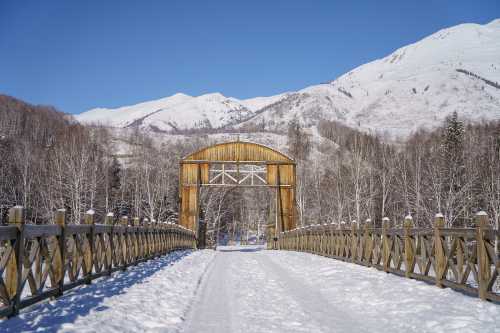Popular Trip Moments
Burqin Three-Day Two-Night Ultimate Guide | Crossing the Secret Realm of Northern Xinjiang! The Ahe Highway Opens, the Ultimate Dream Road for Self-Driving Enthusiasts | The Ahe Highway, the pinnacle of North Xinjiang road trips, is now open! 🚗 | The Ahe Highway is now open! A must-read practical guide for the first batch of experience officers! | 🟤 Hongfu Ecological Resort Hotel: A night of stunning scenery and basic accommodation. | Life is just 30,000 days, so why not make a trip to Xinjiang! | Road trip lovers rejoice! The Ahe Highway in Xinjiang is set to open in September | The Ahe Highway begins trial operation 15 days early! This heavenly road is breathtakingly beautiful | The Ahe Highway is now open! Scenic views like a painting, guide here | This 10-year, 800-million-yuan tourism highway is finally open to traffic! | Xinjiang Ahe Highway | Wallpaper-Level Scenic Road Now Open | The Ahe Highway is about to open, haven't you made plans yet? | My Altay | Snow-Capped Mountains, Log Cabins, Meadows, and Flower Fields | Summer in Altay: Herding Time on the Cloud Pastures | Kanas Lake|The Beauty of a Hidden Paradise, a Summer Resort. 3-Day Travel Itinerary Planning. | Step by Step, A Scenic Journey to the Top|Kanas Fish Viewing Platform | Magnificent Xinjiang | This is not Switzerland but Xinjiang, China | Step into the Cloudy Homeland|Hemu Village in Kanas, Xinjiang | Poetic Altay Station in China: Must-Visit Attractions in Altay | Step into the fairyland of Kanas|A nanny-level guide to see all the snow-capped mountains, forests, and lakes! | Xinjiang Fairy Tale | Falling into God's Palette: Wucaitan Travel Guide | Summer in Xinjiang is Even More Beautiful | A breathtaking view of Kanas' Three Bays | Self-Driving on Xinjiang's Ahe Highway | Stepping into a Miyazaki's Comic World | Back from Hemu, here's some brutally honest truth | Is it really not possible to travel in Xinjiang without a tour guide? | Burqin-Kanas-Jiadengyu | Hiking Kanas: A Healing Journey into the Cover of National Geographic | If there's only one place you can visit in your lifetime, it must be Kanas
Recommended Attractions at Popular Destinations
Attraction near Bangkok | Attraction near Manila | Attraction near Tokyo | Attraction near Taipei | Attraction near Hong Kong | Attraction near Seoul | Attraction near Kuala Lumpur | Attraction near Los Angeles | Attraction near Shanghai | Attraction near New York | Attraction near Shenzhen | Attraction near Osaka | Attraction near Singapore | Attraction near London | Attraction near Guangzhou | Attraction near San Francisco | Attraction near Beijing | Attraction near Macau | Attraction near Bali | Attraction near Jakarta | Attraction near Paris | Attraction near Ho Chi Minh City | Attraction near Istanbul | Attraction near Phuket | Attraction near Chicago | Attraction near Seattle | Attraction near Toronto | Attraction near Orlando | Attraction near Cebu | Attraction near Chiang Mai
Popular Attractions
Safari World Bangkok | Jinshanling Great Wall | Dali Ancient City | Toei Kyoto Studio Park | Ubud | Caohu Region of Rivers and Lakes | Takachiho Gorge | Niu Shou Shan | Okinawa Churaumi Aquarium | Furong Cave | Meridian Gate | Thang Long Water Puppet Theatre | Wellington Zoo | Zoo Negara Malaysia | Wellington Cable Car | SplashMania WaterPark | Queen Mother Pond | The Place to Which Confucius Climbed to Command a Broad View | Adelaide Gaol | Grotta di Cala di Trabucco | Active Rhema Center and Park | Grütt - Skatepark | Rosengarten | BERSIH KOTAKU SANTUN MASYARAKATKU | GİRESUN LİMAN BAŞKANLIĞI | Greengallery | Club de la Plage | Alnada District Park | Base de Loisirs du Lac Bleu | Park Güell
Popular Restaurants in Burqin
喀纳斯花间坊 | 喀纳斯蝴蝶餐厅 | 禾木老村山庄 | 云合小厨 | 禾慕咖啡商店 | 桃源风味餐厅 | YI GE CHI LENG SHUI YU DE DI FANG | Qinhejuhancan | JIA CHANG JIU BAO | 额河冷水鱼庄 | 塔木岚餐厅 | 新疆风味土火锅快餐 | 伊乡饭庄(美食街店) | 老街烧烤城(河堤夜市店) | JIN GUAN JIAO MA JI | 珠帕尔快餐店 | 喀纳斯夜泊酒店·简餐下午茶 | 面面粥道(白湖路店) | 布尔津禾木三等分民宿·三等分奶茶 | 禾木自留地餐吧 | Xin jiang feng wei Restaurant | E LUO SI LAO TAI TAI JI NA SHAO KAO | HE MU TU HUO GUO TU JI GUAN | 禾木简雅民宿·餐厅 | 小乡村熬鱼馆 | 禾木山庄餐厅 | Hemudatou Fast Food | 渔家川湘鱼庄 | 佳客思饭店 | 一头牛牛肉面
Popular Ranked Lists
Popular Premium Hotels in Yamanakako | Popular Luxury Hotels Near Owani | Popular Luxury Hotels Near Pokhara | Popular Premium Hotels in Karbala | Popular Must-Visit Restaurants in Phuket | Popular Must-Visit Restaurants in Chaozhou | Top 10 Best Things to Do in Dandong | Popular Must-Visit Restaurants in Barcelona | Popular Luxury Hotels in Oslo County | Popular Best Things to Do in Renhua | Popular Must-Visit Restaurants in Milan | Popular Must-Visit Restaurants in Chongqing | Popular Must-Visit Restaurants in Hangzhou | Popular Best Things to Do in Boluo | Popular Premium Hotels in Kirov Oblast | Popular Must-Visit Restaurants in Chengdu | Popular Best Things to Do in Dongtai | Popular Best Things to Do in Wuzhishan | Top 3 Luxury Hotels in Tashkent | Top 3 Best Things to Do in Zhaotong | Popular Must-Visit Restaurants in Jeju | Popular Best Things to Do in Lvliang | Popular Best Things to Do in Zhijiang | Popular Must-Visit Restaurants in Melbourne | Popular Luxury Hotels Near Clifden | Popular Luxury Hotels Near Etretat | Popular Best Things to Do in Lichuan | Popular Must-Visit Restaurants in Munich | Popular Must-Visit Restaurants in Nha Trang | Popular Must-Visit Restaurants in New York
Payment Methods
Our Partners
Copyright © 2025 Trip.com Travel Singapore Pte. Ltd. All rights reserved
Site Operator: Trip.com Travel Singapore Pte. Ltd.
Site Operator: Trip.com Travel Singapore Pte. Ltd.

















